News & Info
Article: Sandstorms and desertification in Mongolia, an example of future climate events: a review
Introduction
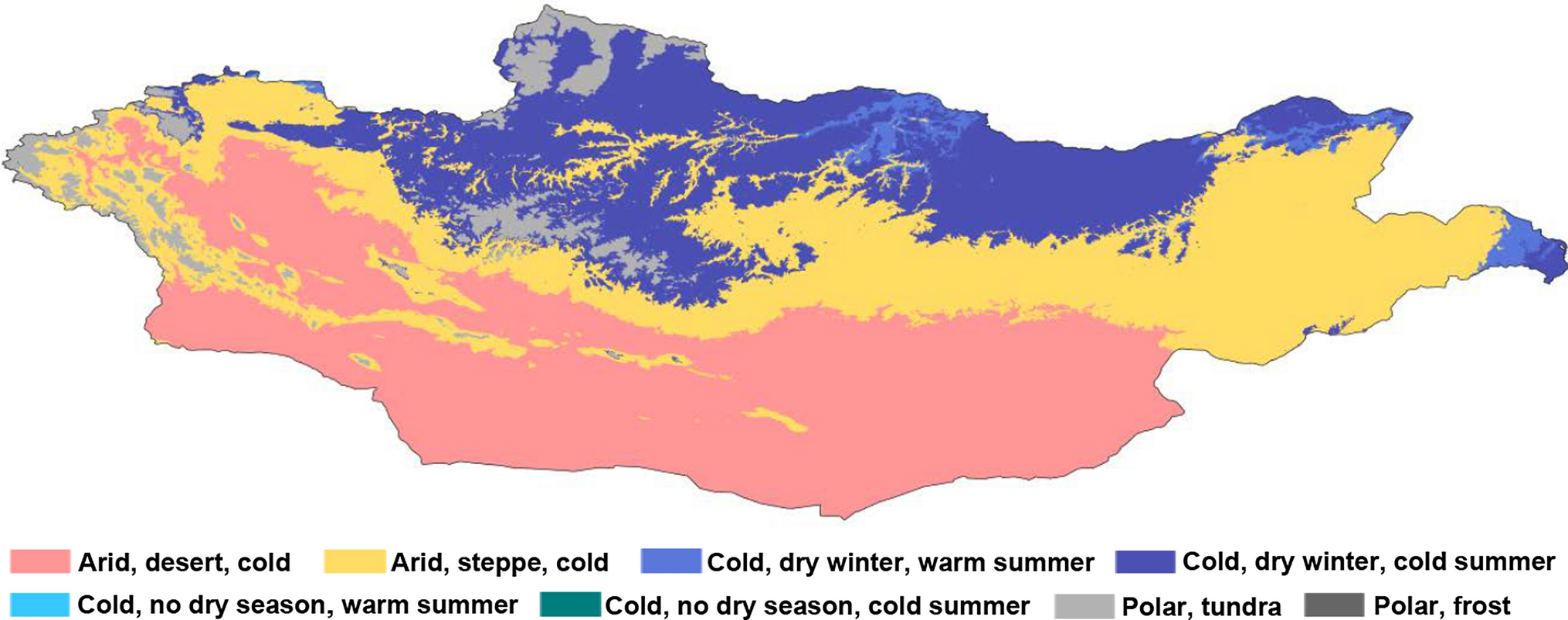
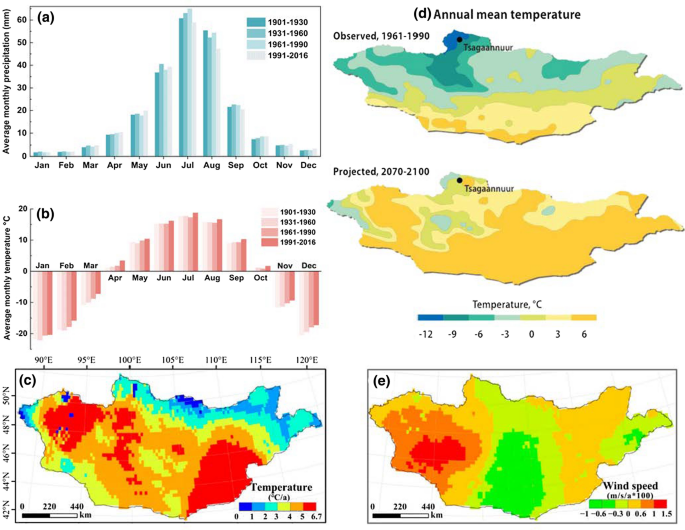
Trends of average monthly precipitation (a) and temperature (b) in Mongolia. Data are accessed via the Climate Change Knowledge Portal for Development Practitioners and Policy Makers, a database maintained and published by the World Bank Group (WBG, 2021). Spatial distribution of annual mean temperature increases (c) and wind speed variations (e) from 1982 to 2015 are reprinted from Meng et al. (2020). Projected annual mean temperature (2070–2100) is reprinted from Ankhtuya (2018)
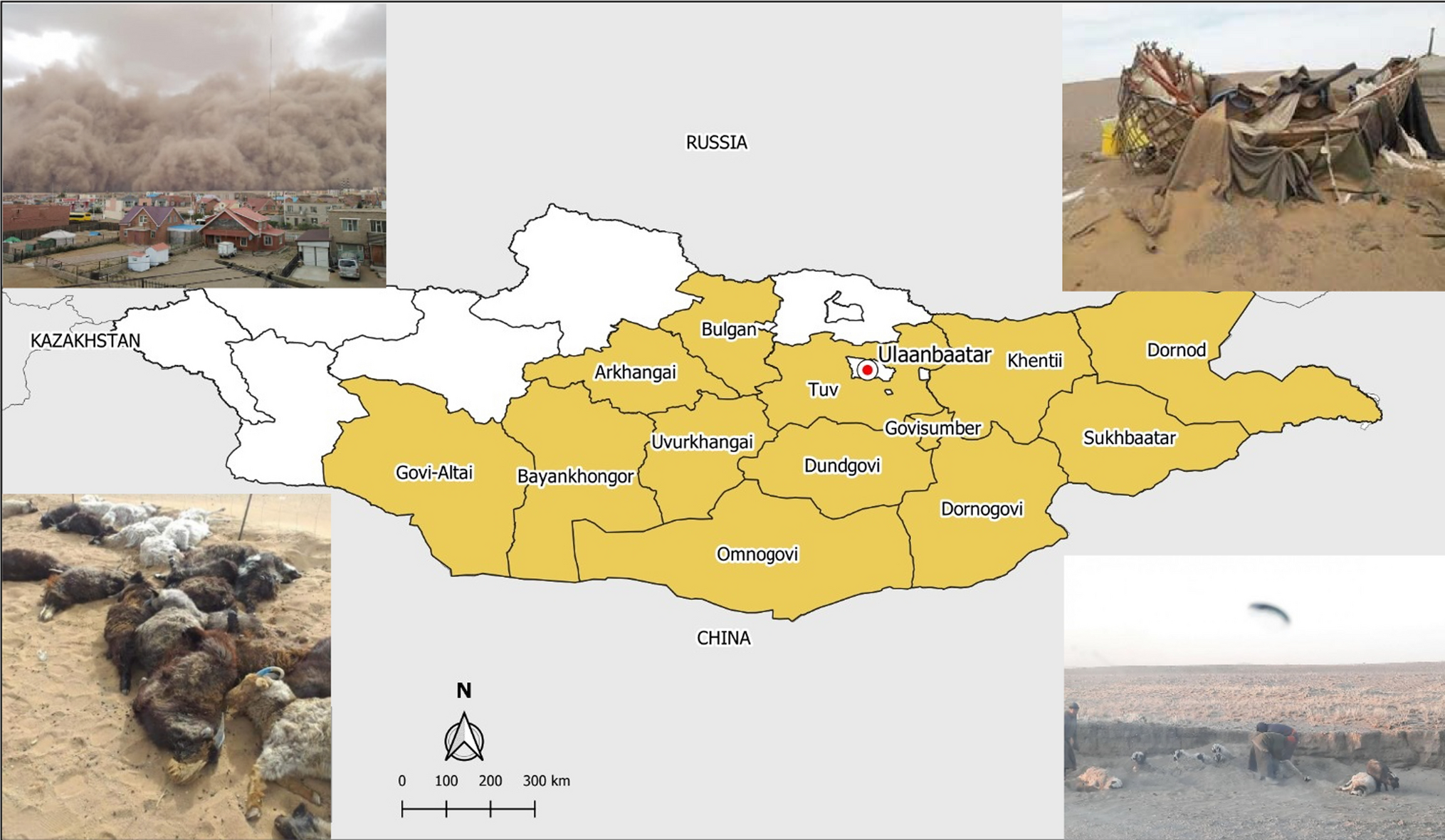
Adapted from the Situation Report published on March 19, 2021 by the International Federation of Red Cross and Red Crescent Societies (IFRC, 2021)
Driving factors for desertification and sandstorms in Mongolia
Dusts and sandstorms are direct consequences of ongoing desertification which, in turn, is exacerbated by intensified climate change impact and anthropogenic activities (Guo et al. 2019; Cilenti et al. 2005; Kaloudas et al. 2021) (Fig. 5). According to the UN Convention to Combat Desertification, approximately 90% of the Mongolian territory is in arid, semi-arid, dry, and sub-humid climatic regions that are susceptible to desertification (Vova et al. 2015). There are many factors that have aided in the desertification process in this region. Of those, a long and irreversible trend of temperature increase, concurrent decrease in annual precipitation, increased evapotranspiration and soil dryness (El-Ramady et al. 2015a, b), as well as widespread land degradation due to overgrazing and human activities are leading factors. Over the past two decades, the magnitude and frequency of weather extremes, most notably droughts and dust storms, have increased by several folds in Mongolia. Extreme and recurring droughts were observed, mostly between june and september, in recent years with both the frequency and severity increased in the past few decades (Fig. 5). In the meantime, meteorological stations throughout Mongolia (n = 34) reported that the number of days observing dust storms each year also increased significantly in recent decades. Dust storms were observed on 18 days in a year in the 1960–1969 period, which increased to 41 days in 1970–1979, 47 days in 1980–1989, 49 days in 1990–1999, and 57 days in 2000–2007, an increase of more than three-fold in four decades (MNETM 2010). While more recent meteorological data are unavailable from the Ministry of Nature, Environment and Tourism of Mongolia, the trend was set to continue with the continuing expansion of the Gobi Desert driven by deforestation and depletion of water resources attributed to human activities as well as climate change (Rossabi 2020).
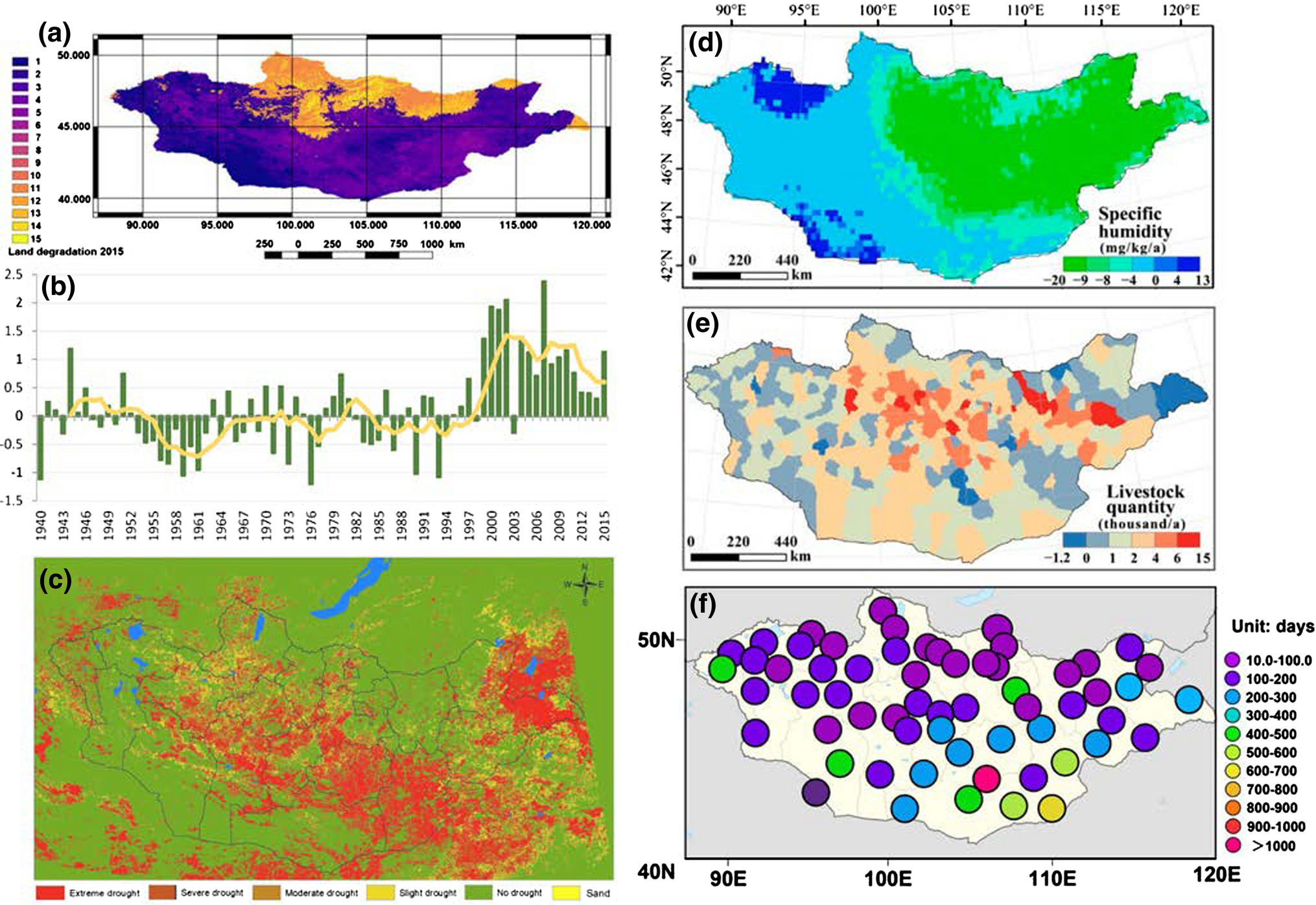
Adopted from the Third National Communication by the Ministry of Environment and Tourism of Mongolia (METM, 2018). (c) A drought map of Mongolia in the ten-day period starting June 21, 2020. Drought conditions persisted over four months (June 1 to September 30, 2020) in Mongolia with varying degrees of severity across the country. Mongolia as a semi-arid and arid country belongs to a region with high risk of drought. In the five successive years between 2015–2020, drought was widely observed in Mongolia, mostly in summer from June to August. Historical drought maps can be accessed from the National Remote Sensing Center, Information and Research Institute of Meteorology, Hydrology and Environment of Mongolia (NRSC, 2021). Spatial distributions of specific humidity (d) and livestock quantity (e) from 1982 to 2015. Reprinted from Meng et al. (2020). Distribution of total dust events (unit: days) from 2000 to 2017 for severe and moderate sandstorms (f). Reprinted from Zhou et al. (2019)
Climate change has been a major driving factor on the local climate in Mongolia. Unprecedented heatwave-drought concurrences have been reported over inner East Asia (i.e., Mongolia and northern China), an area where land-atmospheric coupling has a pronounced role in exacerbating heatwaves and drought. Data recorded at meteorological stations across the country showed that annual mean air temperature increased by 2.24 °C between 1940–2015, and the warmest ten years occurred in the latest decade while annual precipitation decreased by 7% over the past 76 years, resulting in higher aridity across the country (METM 2018). Prior to the recent sandstorms, the country already endured months of reoccurring drought (NRSC 2021). A series of moderate to extreme droughts occurred in its central and southern regions from june through to september 2020, a period when most annual precipitation occurs in the country. Apart from the higher temperatures, low soil moisture, and sparse vegetation also contributed to the severe drought and desertification in some areas. Decreases of specific humidity were evident in central and eastern Mongolia from 1982 to 2015 (Meng et al. 2020), where a negative value of 20 mg kg1 per year was observed in most of these regions (Fig. 5d).
An international group of climate scientists recently securitized heatwave and soil moisture records from local tree ring data and found that the recent consecutive years of record high temperatures and droughts in Mongolia were unprecedented in over 250 years (Zhang et al. 2020). The study also found that record high temperatures in the region are accelerated by soil drying which, in turn, allows direct heat transfers to air due to the lack of moisture kept in soils and subsequent cooling effects induced by evaporation. A positive feedback loop was thus created between soil moisture deficits and surface warming, which causes an abrupt shift to a hotter and drier climate in the region. In an earlier survey, researchers found that more than a quarter of the lakes greater than 1.0-km2 in the Mongolian Plateau had disappeared between 1987–2010 (Tao et al. 2015). Of those, 63 lakes (17.6%) in Mongolia had dried up, including 58 small lakes (1–10 km2), four medium-size lakes (10–50 km2), and one large lake with an area size greater than 50 km2. In a period of just over 20 years, the lake area in Mongolia diminished by 332 km2, representing 2.4% of the total lake area in the inland country. On a longer timescale, the annual reconstruction of the Palmer Drought Severity Index (PDSI) spanning over a course of 2060 years showed that recent extreme drought observed on the Mongolian Plateau were highly unusual, which exceeded a 900 year return interval (Hessl et al. 2018). Both the magnitude and pace of those recent changes promoted warnings that the semi-arid region may have entered a new climate regime, in which soil and surface water could no longer mitigate high temperatures and provide adequate precipitation, a failure that can have devastating consequences on the country’s agricultural sector.
In addition to a drying landscape, overgrazing caused ubiquitous soil and pasture degradation on the vast pasture land, while intensified human activities such as coal mining also contributed to land degradation. Over the past 30 years, grazing intensity has steadily increased across the country (METM 2018). The trend, which started from the early 1990s, accelerated abruptly from 2004, and so was coal mining (from ca. 2000) (Tao et al. 2015). Based on the situation assessment of desertification and land degradation in 2015, more than three-quarters of land (77%) in Mongolia were affected by desertification and land degradation, and nearly a quarter of its land (23%) was considered highly or very highly degraded (METM 2018). Satellite data showed clear evidence that, over a course of 15 years (2001–2015), varying degrees of pasture degradation, i.e., from ‘slight’ to ‘severe’ occurred in most parts of the country due to ubiquitous overgrazing, where the number of livestock exceeded pasture capacity, in addition to the increasing droughts and soil dryness. According to the National Statistical Office of Mongolia, there had been an overwhelming growth in livestock quantity from 24.8–56.0 million between 1982 and 2015, which reached 66.2 million by 2018 (Fig. 5). Studies on changes of livestock heads per unit grazing area found that the number of livestock per 100 hectares of pasture land increased from 40–50 sheep unit (i.e., number of livestock equivalent to sheep heads) between 1980–2000 to 60–70 sheep unit per unit area between 2000–2015. The most abrupt increase was observed from 2010–2015 (METM 2018). The trend was likely to have continued to the present year as indicated by the increasing outputs from the agricultural sector in Mongolia over the last five years (MSIS 2021a).
An ecological imperative
Increased temperatures, coupled with decreased precipitation and ubiquitous land degradation, resulted in a persisting drying trend affecting pastures and water sources in Mongolia, and triggering sustained population shifts to urban regions. Facing drought, desertification, climate change, overgrazing, and mining damage to pasture land, herders who could not make a living continued to migrate to Ulaanbaatar, the capital of Mongolia, and lived in gers (tents). In fact, inhabitants of gers (tents) constitute about 60% of the total population in Ulaanbaatar (Rossabi 2020), who are particularly vulnerable to damages by weather extremes such as heatwaves and sandstorms (Fig. 6). In the Third National Communication, the Ministry of Environment and Tourism of Mongolia (METM 2018) estimated that the frequency of disastrous events related to atmospheric phenomena would increase by 23–60% by the middle of this century in any climate change scenario evaluated. In addition, projection data on 2030–2080 painted a dire picture on soil fertility and pasture yield in Mongolia, should the current trends continue without human intervention (METM 2018).
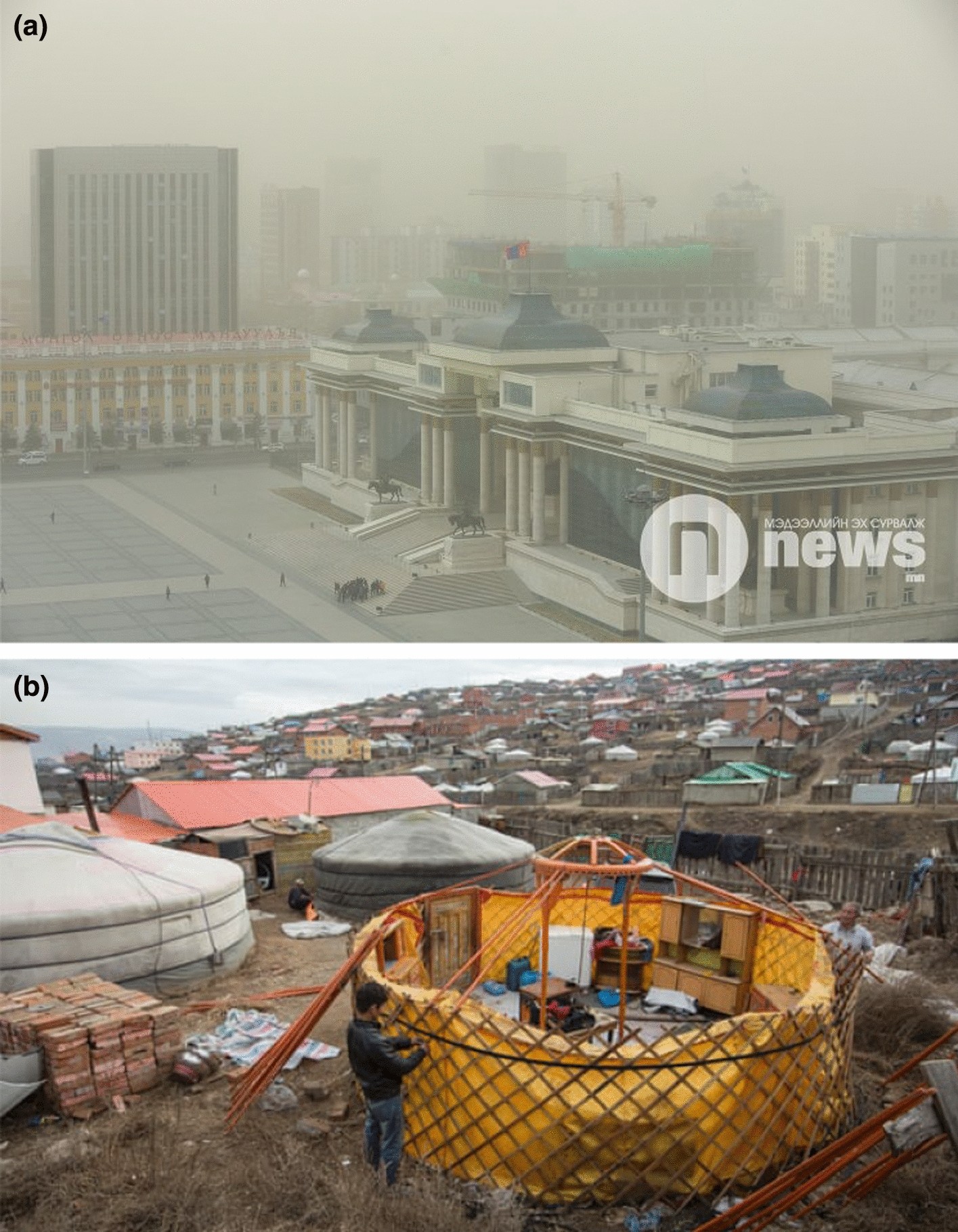
Source: News.mn (Ankhtuya 2019). (b) A ger district on the outskirts of Ulaanbaatar. Many of those who now live in the ger district are former herders. Most ger districts are not connected to public water supplies or sanitary systems. Source: Dan Chung of The Guardian (Chung 2021)
Neighboring with Mongolia, China has endured and battled with desertification and sandstorms for decades in its northern provinces (Feng et al. 2015; Yu et al. 2014; Gu et al. 2021). Due to its proximity to the Gobi Desert, Beijing—as other cities situated in the Mongolian Plateau—has a sandy past with recurring ‘yellow dust’ in spring. Yet, those vast, sky-darkening sandstorms seen between March 15 and April 15 this year may have become remote memories for its residents. Since the late 1970s, the Chinese government invested tremendous resources in the ‘Three-North Shelter Forest Program’ to reverse desertification and mitigate sandstorms by planting aspens and other fast-growing trees on approximately 36.5 million hectares of land in 12 northern provinces. Efforts further accelerated in its northern and northwestern regions since the early 2000s to mitigate desertification and remediate land degradation to block winds and to fixate sands and soils by reforestation. The average number of sandy days fell sharply in Beijing, from 25 in the 1950s to three in 2010, and sandstorms became rare in the past ten years.
As one of the countries that are most severely impacted by climate change and desertification, Mongolia is a developing nation with a vast land territory and a small population with a modest human development index (Fig. 7). Yet, its governments and residents are facing a daunting and rapidly aggravating ecological challenge. Ecological remediation of this scale requires vast resources, expertise, and decades of persisting efforts (Fawzy et al. 2020). The 2021 East Asia sandstorm has drawn international attention to ecological issues that have been culminating for decades in Mongolia. Addressing these issues would require decades of collaborative efforts from climate, ecological, atmospheric, and environmental scientists from the local and global research communities. In the renowned Mongolian folk song ‘The Night of Ulaanbaatar’, the songwriter painted the tranquility of life and picturesque landscape in Ulaanbaatar. It is now a matter of actions for its regulators, scientists, and residents to regain such lifestyles in the ‘country of eternal blue sky’.
Conclusion
The 2021 East Asia sandstorms drew international attention to ecological issues that have culminated for decades in Mongolia, a landlocked country with vast arid and semi-arid land that is highly vulnerable to climate change. In the past few decades, the country has battled with severe, recurring droughts and vast, increasingly frequent sandstorms. Recognizing the key driving factors is of great importance for fighting against the ongoing desertification and dust storms in the Mongolia Plateau. By securitizing long-term climate data, we found persisting trends of temperature rise and precipitation decrease in Mongolia. Meanwhile, intensifying overgrazing and human activities caused rapid and abrupt increases of land degradation in some regions. Climate factors and land degradation have resulted in a positive feedback loop between soil moisture deficits and surface warming in the region, yielding a hotter, and drier climate regime with unprecedented drought witnessed in recent years. There is, however, major knowledge gaps that most existing data and models failed to take the spatial heterogeneity of variables into account, which is highly relevant given the vast land territory and sparse distribution of population in Mongolia. Since overgrazing and human activities are primary driving factors of land degradation in many regions, there is also a need to devise more accurate, area-specific models to identify the key driving factors and to implement mitigation strategies. Governments and residents in Mongolia are facing a daunting and rapidly aggravating ecological crisis which requires tremendous resources and expertise to remediate in the next few decades. Ecological restoration on such a vast scale requires persisting and collaborative efforts from scientists around the world, in which environmental and atmospheric scientists have a pivotal role to take in tackling this grand ecological challenge.
